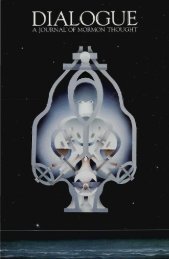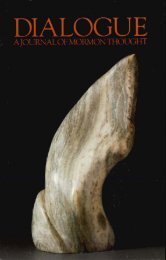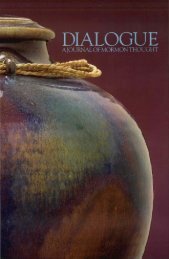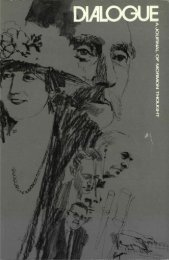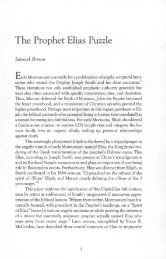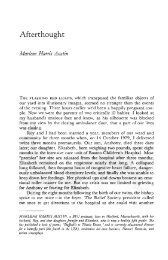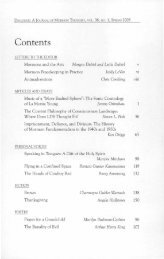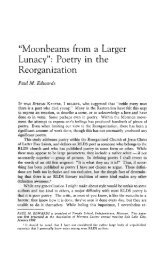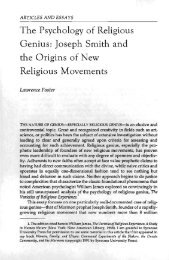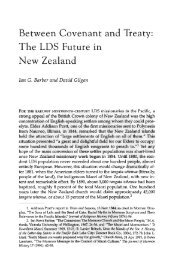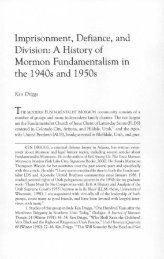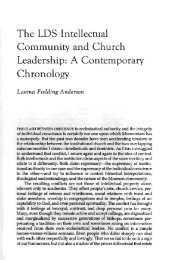Dialogue, Volume 25, Number 2 - Dialogue – A Journal of Mormon ...
Dialogue, Volume 25, Number 2 - Dialogue – A Journal of Mormon ...
Dialogue, Volume 25, Number 2 - Dialogue – A Journal of Mormon ...
Create successful ePaper yourself
Turn your PDF publications into a flip-book with our unique Google optimized e-Paper software.
74 DIALOGUE: A JOURNAL OF MORMON THOUGHT<br />
But certain aspects <strong>of</strong> the LDS culture can bar even women from<br />
enlightening themselves through personal narrative. Since 1984 I have<br />
taught English 218R —Introduction to Creative Writing, with an<br />
emphasis in literary nonfiction — at Brigham Young University. In these<br />
classes, I have watched men and women resist coming to terms with<br />
the contradictions <strong>of</strong> their lives. For Latter-day Saint women, in particular,<br />
such resistance comes from three general sources: lack <strong>of</strong> time,<br />
because setting aside large blocks <strong>of</strong> quiet, self-reflective time is difficult<br />
when you're busy rearing children, caring for a home, and more<br />
<strong>of</strong>ten than not, working; lack <strong>of</strong> knowledge about women's stories, which<br />
are infrequently mentioned in the scriptures and only recently making<br />
their way into Church lesson manuals; and fear <strong>of</strong> recrimination from<br />
family or from <strong>of</strong>ficial sources for expressing negative emotions, disagreement,<br />
or deviant thought processes.<br />
Both men and women grapple with these problems, but Latter-day<br />
Saint women may feel more pressure to keep busy, write the family<br />
documents, perfect themselves, and nurture. The positive public image<br />
many women seek leaves little room for inevitable negative personal<br />
experiences or emotions.<br />
In my classes, I try to help would-be memoirists overcome these<br />
barriers by providing structured time, abundant reading material, and<br />
plenty <strong>of</strong> theory and practice. Working together, we establish the personal<br />
narrative as the prototypical discourse (Langellier 1989, 243).<br />
We learn that telling a story forms the basis for all discourse. We read<br />
the works <strong>of</strong> women writers whose lives shape their material, from<br />
Julian <strong>of</strong> Norwich and Margery Kemp in the Middle Ages to Annie<br />
Dillard and Alice Walker in twentieth-century America, to Latter-day<br />
Saint women writers such as Emma Lou Thayne, Mary Bradford, and<br />
Helen Candland Stark. We perform writing exercises that allow memory<br />
and feeling to rise to the surface and find form in words. (The<br />
suggestions in Natalie Goldberg's Writing Down the Bones and Wild<br />
Mind, and in Gabrielle Rico's Writing the Natural Way are my personal<br />
favorites.) Though these exercises are not always successful, when my<br />
students finally push through their resistance and produce fine essays<br />
similar to the ones that follow, we all reap remarkable rewards.<br />
The first reward <strong>of</strong> producing a polished personal essay is pleasure—on<br />
many levels. Lorinne Taylor Morris took English 218R twice<br />
because the first time she took it, she struggled with an essay about<br />
her mother's death for months, saying to me several times, "I don't<br />
even know what I'm trying to say here." I encouraged her to continue<br />
to work with it, praising the understated tone and the importance <strong>of</strong><br />
the story itself. When she finally came to a satisfactory ending, she<br />
said, "Now I know what I meant. I thought I was writing about how I



